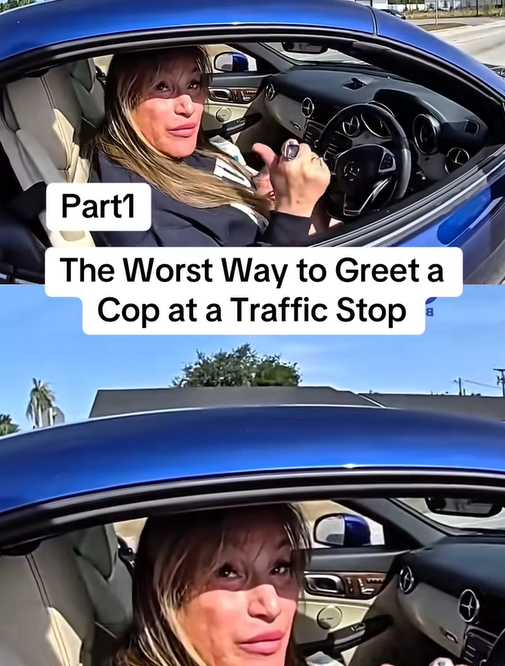Thought for 11s
TRANS DRIVER’S WILD STANDOFF: “YOU CAN’T ARREST ME – I’M TRANSGENDER!” – COPS STUNNED AS TRAFFIC STOP ERUPTS!
It was a balmy evening in a mid-sized city, where the sun dipped low behind strip malls and traffic hummed like a distant beehive. Blue and red lights pierced the dusk as a patrol car signaled a sleek sedan to the shoulder of a busy boulevard. The driver, a poised individual in flowing attire that hinted at a recent wellness session, eased over without haste, but what started as a routine stop for a minor infraction—a flickering brake light—quickly spiraled into a confrontation that would ignite debates, rack up viral views, and leave officers scratching their heads in disbelief.
The officer approached the window with standard protocol, flashlight in hand, voice steady: “License and registration, please.” But instead of compliance, the driver met the request with a defiant glare, rolling down the glass just enough to declare, “You can’t touch me—I’m transgender!” The words hung in the air like a challenge, catching the cop off guard. Bodycam footage, which would later leak and explode across social platforms, captured the moment in raw detail: the driver’s hands gripping the wheel tightly, eyes flashing with a mix of fear and fury, as if this revelation was an impenetrable shield against authority.
As the seconds stretched into minutes, the driver elaborated, voice rising in pitch and volume. “This is discrimination! You’re profiling me because of who I am!” The officer, trained for de-escalation, tried to steer back to the basics—explaining the stop was purely for the vehicle issue—but the response was a barrage of accusations. Passersby slowed their cars, phones emerging from pockets to record the unfolding drama, turning the roadside into an impromptu stage. The driver refused to hand over documents, insisting that any enforcement would violate personal rights tied to gender identity, weaving in tales of past hardships and systemic biases that fueled the resistance.
Backup arrived swiftly, two more units pulling up with lights swirling, forming a semicircle around the sedan. The driver, now standing outside the vehicle despite warnings, paced back and forth, phone in hand, live-streaming the encounter to an audience that grew by the thousands in real-time. “See this? They’re harassing me because I’m trans!” Comments flooded in—supportive hearts from allies, skeptical thumbs-down from detractors—while the officers maintained a perimeter, radios buzzing with calls for guidance from higher-ups. One tried reasoning: “This isn’t about that; it’s about safety on the road.” But the plea fell on deaf ears, met with shouts of “Bigotry!” and demands for a supervisor who “understands diversity.”
The standoff dragged on, evolving from tense words to physical resistance. When an officer reached for the door to secure the scene, the driver shoved back, not violently but enough to escalate protocols. Handcuffs came out, clicking amid protests of “You have no right! My identity protects me!” The bodycam shook slightly as the struggle ensued—a brief tussle on the asphalt, ending with the driver subdued and seated in the patrol car. Searches revealed no contraband, just a wallet with ID that confirmed the claims, but the charges piled up: resisting arrest, obstruction, and the original ticket that could have been resolved in moments.
In the hours that followed, as the driver was processed at the station, the video spread like wildfire. TikTok edits synced the outburst to dramatic music, Reddit threads dissected every frame for legal nuances, and news outlets picked it up as a flashpoint in ongoing discussions about policing and marginalized communities. Advocates rallied, calling it an example of overreach, while critics labeled it entitlement disguised as activism. The department issued a statement defending the stop as routine, emphasizing bodycam transparency, but the damage was done—protests brewed outside headquarters, hashtags trended, and training programs scrambled to incorporate “sensitivity scenarios.”
Weeks later, the case wound through courts, with the driver pleading not guilty, framing the resistance as a stand against injustice. Expert witnesses debated the intersection of traffic laws and civil rights, turning a simple pullover into a national conversation. Families watched replays over dinner, debating: Was it defiance born of trauma, or a misguided bid for immunity? Officers involved reflected in quiet moments, wondering how a brake light led to this. The driver, released on bail, doubled down in interviews, vowing to fight for “trans protections on the road.”
Yet, the ripple effects lingered far beyond the courtroom. Social media algorithms amplified the clip, influencing policies in distant departments and inspiring copycat incidents. Support groups formed online, sharing stories of similar encounters, while skeptics warned of the dangers in exploiting identity for evasion. In the end, what began under flashing lights became a mirror to society’s fractures—where personal truths clash with public order, leaving everyone to ponder the fine line between resistance and recklessness.
And as nights fall on that same boulevard, blue lights continue to flash, a silent reminder that any stop could unravel into the unexpected, forever altering lives in the blink of an eye. What hidden stories wait in the next pull-over? The road holds its secrets tight.
